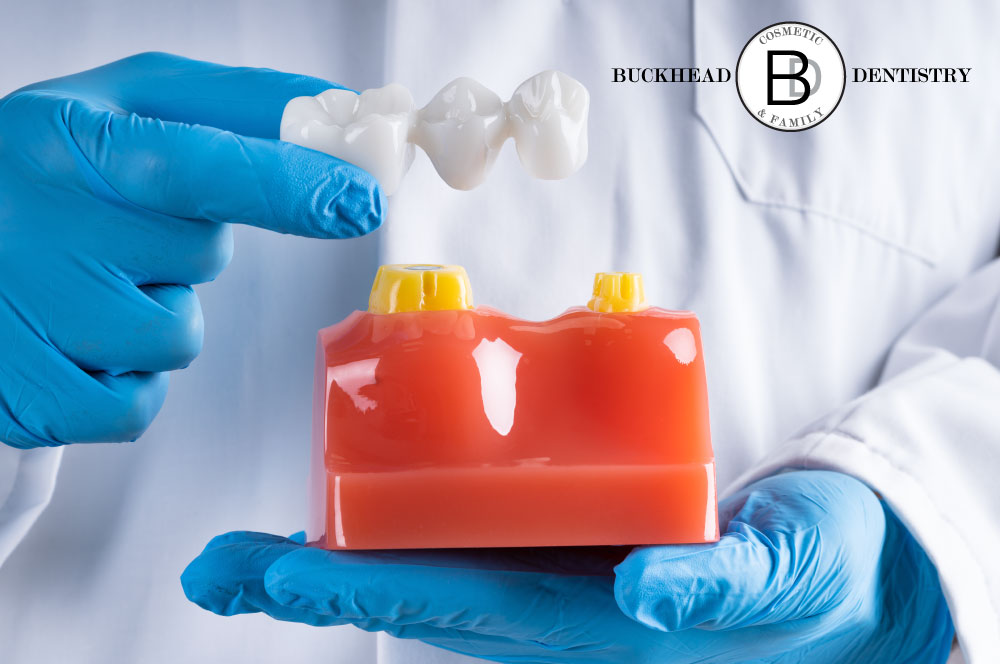Visit the Patient Center to learn what to expect from your first visit, forms, financial policies, and frequently asked questions!
What Are the Benefits of Dental Bridges?

Not everyone goes to the dentist for a routine dental cleaning or simple fluoride application. Sometimes, you require help from a professional to restore your smile and ensure the proper function of your dental structures. When we talk about the many solutions you can find at Buckhead Dentistry, we can’t fail to mention dental bridges.
When we say “dental bridge” we’re not exactly talking about a dental implant. Furthermore, this resource helps many patients recover the full function of their mouth and avoid a whole sleuth of additional complications. Are dental bridges right for you? What are they? What are some types of dental bridges? Let’s find out.
What Is a Dental Bridge?
A dental bridge is what we refer to as a “pontic.” Pontics are basically false teeth that, unlike dental implants, don’t require always a surgically-implanted anchor to remain in place.
We make these pieces in a laboratory and their function is to primarily cover existing teeth or cover spaces left behind by lost teeth. Fortunately, bridges can help you cover as little as a single tooth, or many teeth at a time, making them a versatile resource for dentists to help patients of various backgrounds.
When should you get a dental bridge? Well, you’ll want to get in touch with our team to get a dental bridge if you have one or several teeth missing. Older patients in need of restorative treatments might benefit from the solutions you can only get with dental bridges. You’ll make a great candidate for treatment with dental bridges when you have healthy bone tissue around the target area for the treatment and no complex dental health issues.
Granted, as with anything in dentistry, there are plenty of choices at your disposal, so let’s review the types of dental bridges.
Types of Dental Bridges
When you consider talking to your dentist about a dental bridge, take into consideration there are four types:
- Traditional,
- Cantilever,
- Maryland,
- Implant-supported.
Traditional Dental Bridge
Let’s talk basics. A traditional dental bridge is essentially a false tooth that remains in place thanks to a couple of dental crowns next to it. These crowns are not removable pieces, rather, your dentist bonds them to the abutment teeth. Don’t worry; abutment refers simply to the surrounding teeth that hold a bridge in place.
This is definitely the most popular type of dental bridge, and it helps patients who still have partial or complete natural teeth next to the space they’re trying to fill.
Cantilever Dental Bridge
This type of dental bridge is similar in nature and function to a traditional one. However, where a traditional bridge requires natural teeth on both sides of the space you’re trying to cover, a cantilever dental bridge only requires one dental crown as an anchor.
Your dentist will leverage one dental crown and cement it to a single abutment tooth to hold your cantilever bridge in place. If there aren’t two healthy teeth to support a traditional bridge, your dentist will consider using this type of bridge. This alternative is by no means ineffective and you should talk with your dentist about all your options.
Maryland Bridge
Naturally, this is a variation on the traditional dental bridge we explained a little while ago. Just like a traditional one, a Maryland bridge will require two abutment teeth to each side of the space we’re trying to cover. However, there is a main difference.
Instead of relying on dental crowns to remain in place, a Maryland bridge will require a different framework bonded to the lingual side of the abutment teeth by a professional dentist.
This framework can be of stainless steel or ceramic materials. You can also ask about a resin-bonded partial denture and it will be this type of dental bridge. The false tooth sits between the two supporting teeth and acts like a more conservative treatment because it won’t fully cover the surrounding teeth.
Implant-Supported Dental Bridge
Next in line is the implant-supported dental bridge. Instead of relying on dental crowns or specially made frameworks, this type of bridge requires the surgical insertion of dental implants. Typically, you will require one dental implant per missing tooth, and it’s these implants that hold the bridge in place. If there are circumstances preventing the insertion of a dental implant, then your dentist might consider having a pontic between two implant-supported crowns.
This alternative is perhaps the most durable and stable system, but the process is more invasive and slightly longer.
How Much Is a Dental Bridge?
As you may already know, estimating costs in dentistry is only possible when you are in consultation with a dentist. There are too many factors that influence the final cost of treatment. Here are some of these factors:
- How many fake teeth will fill the gap.
- The materials you choose for your bridge and supporting structures.
- The complexity of placement.
- Additional treatments to supporting and surrounding tissues.
- The type of dental bridge you choose to wear.
Costs may range anywhere from $1,500 to $15,000 depending on several factors.
Learn more on our blog!
Stay up to date on your dental health and hygiene with our blog!



